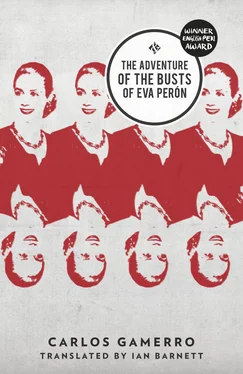‘Along this one?’
‘No, you’re heading for the nose that way. No, if you want the bun, you go straight on down here, and then… You’ll see a big square, somewhere around the cheek… Turn left and keep going… There’s a big tall building right in the middle of the bun — a five-storey tower block. The house you’re looking for is right opposite. Can’t miss it.’
And indeed he couldn’t, but it was more than ten blocks in the blazing sun and more than once he felt like throwing in the towel. He couldn’t have said what kept him going: it didn’t feel as though it was him but the houses that were moving, filing past him on either side like a procession, displaying all the personal touches that the inhabitants’ instinctive sense of difference had added to the basic Peronist bungalow: spear-headed railings, slate or wood cladding, porches, bay windows and quaint colonial streetlamps. The house he was looking for turned out to be on a corner, one with a rounded chamfer rather than the usual angled one, and a lawn that sloped to a low, trim privet fence, beyond which a rich array of statues and fountains was spread across the kempt front garden. This was the house. Outside the front gate, in the shade of an old red pick-up with a wooden box, a girl and a boy in swimming costumes were playing with watering cans, toy buckets and a hose-pipe.
‘Hello, lamb. I’m looking for Sr Rogelio,’ said Marroné, addressing the boy in as friendly a tone as he could, but when the girl started to wail and the boy to shout ‘Grandpa! Grandpa!’ with barely contained alarm, he decided he hadn’t hit the right note.
The man didn’t emerge from the house but from an adjoining shed, evidently an extension of the original bungalow. He must have been somewhere between sixty and seventy, with white hair and dark skin, and his eyes were black and bright, like pebbles in a basket of wrinkles. He could, Marroné felt, have been his own grandfather — the original, not the fake. He was wearing a canvas apron over his loose-fitting clothes and clutched a hammer and chisel in his strong sculptor’s hands. His grandchildren had clung to his legs and peeked out from behind them.
‘Yes?’ he asked tentatively, putting away the chisel in an apron pocket but still gripping the hammer. ‘Are you looking for someone?’
‘We spoke on the telephone. It’s about the busts.’
* * *
He had leant on the gate to steady himself, and the grandfather had helped him to the kitchen, where he recovered sufficiently over biscuits and maté to explain what he’d come for.
‘My name’s Ernesto and I’m… well, you know, with the special forc… no, I mean the revolutionary… You must have come across our…’ he said hopefully, but seeing the man’s growing confusion, he was forced to be specific: ‘In the Montoneros. So, as part of the programme for deprived areas, we want every shanty town to have its very own bust of Eva…’
Don Rogelio listened to him carefully, his calm, kind eyes fixed on him, and, feeling uncomfortable with the baldness of his flagrant lies, Marroné decided to season them with a pinch of truth.
‘I’m on the run, Don Rogelio. At this moment I’m being pursued by the union mob, the Triple A and the police. I look like this because I’ve been hiding away in a garbage tip. If they get their hands on me…’
Rogelio put one of his hands on his, covering it completely.
‘Don’t you worry now, Ernesto. They can’t get to you here. You’re inside Eva now.’
He pointed to a picture on the wall; it was just a page torn from a Filcar street guide, coloured in and covered with notes and numbers; a map whose blocks, squares, streets, train tracks and freeways formed, sharp and clear against the background of empty lots that encircled it, the unmistakeable outline of a bust of Eva. Marroné’s first reaction was to think he was hallucinating again, but as he began to find his way round the fantastic cartography, he remembered he was in Ciudad Evita, the model village whose outline had indelibly stamped the profile of Eva Perón on the surface of the pampas. Don Rogelio, meanwhile, had started to outline his theory about the inviolability of this Peronist Jerusalem.
‘Don’t forget that the figures of the General and Eva came in for some pretty brutal treatment after the coup against Perón — what they called “the Liberating Revolution”, but what we knew was our return to bondage. Rampant iconoclasm it was: pictures, posters, busts — no image was spared… Except this one, the biggest of all: maybe because it is so vast that, like the Nazca Lines in Peru, it can only be seen from the sky. Ironic, isn’t it? At one time there were rumours about them bringing in bulldozers and teams of conscripts, or radical and socialist volunteers, to alter the street plan and change her profile to Sarmiento’s or Yrigoyen’s; so we took turns on guard duty for several nights, all set to make a stand, even prepared to lay ourselves down in front of the machines as a last resort; but in the end they never came. One possibility that occurred to us later was that they could just as easily obliterate her features by building new neighbourhoods around them: but, besides being expensive, it wouldn’t have been any use, because Eva’s profile would still have been there, hidden yet visible at the same time, like those figures you sometimes discover hiding within a picture of another subject. So we eventually came up with the theory that Eva’s outline is like a magic circle, a stockade against the gorillas lying in wait in the jungle beyond. In here at least there’s still an island of the Argentina she dreamt up for us, the Argentina they stole from us after she died.’
Don Rogelio’s serene, unhurried voice soothed him like a lullaby: Eva’s protecting you — You’re inside her — Eva’s Island — Eva loves you — Eva will look after you.
He awoke with a start from his nodding, his head nearly on his knees.
‘So everything in our power we can do…’ Don Rogelio had carried on. ‘The doors of this house are never closed to a comrade on the run. Do you have any idea of the times I’ve had to hide? And been spared the nick by the help of a neighbour or a stranger? Actually, if you need houses, or families to hide your people in… I’m kind of in charge of neighbourhood business. We stick together in this place, Peronists through thick and thin; not the kind who go around shouting “Viva Perón” on 17th October and keep their mouths shut on 16th June. Alright, come on, I’ll show you the workshop before you drop off in that chair.’
In his short walk through the garden he’d already had the opportunity to see that Don Rogelio’s work married a pure and delicate love of matter with a dubious taste for the plebeian. Proof of the former lay in his onyxes, marbles and granites, which seemed to be shaped more by the caresses of a loving hand than by the blows of a hammer, and in his polished woodcarvings, which seemed to have been moulded in some previous liquid state; proof of the latter, in the proliferation of shepherds, shepherdesses and naked nymphs, of gauchos with rugged, whittled features, and indomitable Indians with tensed throats and prominent teeth. Marroné, however, only took this in fleetingly and obliquely, for his eyes had locked like traps onto a shell-like forehead, a delicate swan neck and a cascade of loose hair pouring over translucent alabaster shoulders.
‘It’s her, isn’t it?’ he asked in hushed reverence.
Don Rogelio nodded, silent and smiling. At that moment his two grandchildren came in — still regarding the shabby, bug-eyed Marroné with suspicion — and sat down, one on each of their grandfather’s knees. He waited until they’d made themselves comfortable before beginning his story.
Читать дальше











